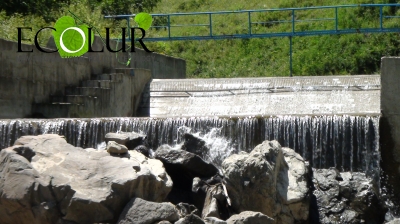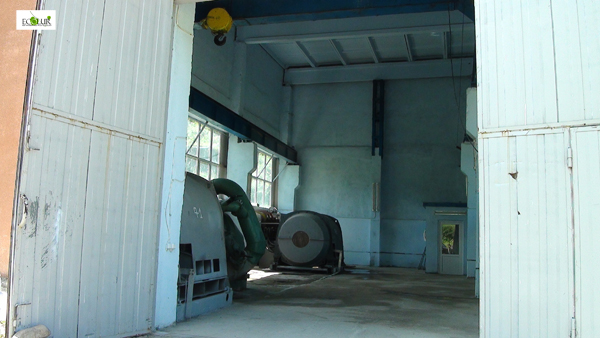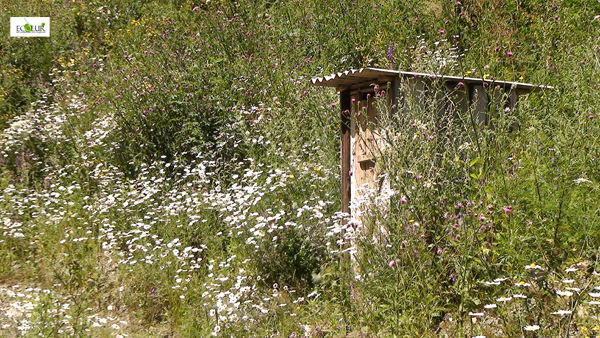

EcoLur
In the framework of the project entitled “Support to the Reforms of SHPPs through a Dialogue between the Public and The Ministry of Nature Protection of the RA for the Purpose of River Ecosystem Use” the expert group visited “Dzoraget 5” SHPP. “Dzoraget 5” SHPP is located in the administrative area of Katnarat community, Lori Region. The SHPP is constructed on the Dzoraget River (length – 67 km).
As a result of the monitoring, the expert group found out:
- The SHPP has been operating since 2013.
- “Dzoraget 5” and “Dzoraget 6” SHPPs are considered to be cascade SHPPs. The water flowing out of “Dzoraget 5” SHPP station is directed to the head section of “Dzoraget 6” SHPP through drainage canal.
- The static pressure of the SHPP isn’t mentioned in the project. According to the project, estimated pressure –55.84, the estimated yield used by the SHPP is 4.0m3/s, projected capacity – 1.78 MW, according to the certificate issued by the Public Services Regulatory Committee, capacity – 1150 kW . According to the certificate issued by the Public Services Regulatory Committee, the factual useful delivery of the electricity is 3.9 million kWh. According to the project, the estimated production is 6.12 million kWh, duration of license - 04.09.2013-04.09.2028, water usage permit - 04.04.2014-04.04.2017.
- The head section has been constructed with certain project deviations.
- The dam should have been 2 meters high and 12.25 meter long according to the project, but in reality it’s 2.5 meters high and 17 meters long.
- A stair-like fish passway made of concrete has been constructed in the head section. It has been projected and constructed not in line with the set criteria. In a distance of around 20 meters below the fish passway there is another passway of about 2-2.5 meters high with no fish passway, which makes the natural movement of the fish to the constructed fish passway impossible.
- There is a garbage collector of 3.70 meters long, while 10-centimeter long young fish can flow through its bars and find themselves in the pressure pipeline of the SHPP.
- Fish-protecting net is missing in the SHPP head section.
- You can meet brown trout (Salmo fario) in the part of the Dzoraget River, where SHPP head section is constructed. If other hydrotechnical structures were not constructed down the SHPP head section, you could have met Kura barbell, the South Caspian sprilin and other species.
- According to the water usage permit data, the SHPP can take water from the Dzoraget for 12 months ensuring the environmental flow of 0.2 m3/s in the river.
- According to “Computation Center” CJSC data, in 2014 “Dzoraget 5” SHPP operated for 12 months and produced 2641658 kW electricity.
- The technical solutions of laying a pressure pipeline comply with the project solutions. The pressure pipeline length complies with the project data is 1850 meters, its diameter is 1200mm. It’s partially buried, reclaiming has been carried out. There are certain landslide phenomena in some parts of pipeline laying which can cause accidents for pipeline operation.
- Percentage correlation of aggregate lenght (10110 meters) of 'Katnarat' SHPP (according to project, length of derivation – 3450 meters), 'Dzoraget 5' SHPP (according to project, length of derivation – 1850 meters), 'Dzoraget 6' SHPP (according to project, length of derivation – 2360 meters), and “DzoraHEK” (length of derivation – 2450 meters) constructed on the Dzoraget River with the length of Dzoraget River makes up 15.08%.
- According to the project solutions, site development works have been carried out in the station are, nevertheless, greening measures are not sufficient.
- Two turbines of local production – “Tsatryan” LLC, have been installed in the station instead of projected three ones. At the moment of observation two turbines were operation with 1685 l/s water amount ensuring 23352 kW capacity. Most water amount has been used in May, when the SHPP with its two turbines ensured the projected capacity.
- The transformer station is fenced, where two transformers are located, which are not equipped with oil-collecting system.
- There is no landscape disfigurement.
- According to the project solutions, there is a toilet constructed with water-proof well for waste discharge.
- There is no water-meter sealed by a relevant environmental body in the water intake.
- There is no automatic management system of the water level in the water intake.
- In 2014 the State Environmental Inspection carried out inspections in the SHPP and imposed an administrative fine of 200,000 AMD for not performing the requirements of water usage.
Conclusion
Because of incorrect projecting and construction the fish passway doesn’t serve its purposes. Under such conditions of water amount and artificial water flow the movement of the fish up and down the river is not possible.
The environmental flow of 0.2 m3/s laid down in the water usage permit is not sufficient for the river.
There are no problems with the irrigation, as water is not used for irrigation purposes in this section of the river.
Proposals
- To carry out rehabilitation works of the water intake section for the projecting and constructing of the fish passway taking into consideration the hydrological description of the river and the fish species inherent to the river.
- To install a fish-protecting net till the pressure pipeline.
- To review the indicators laid down in the water usage permit thus increasing the limit of the environmental flow.
- To carry out control of the environmental flow amount by installing a water-meter sealed by a relevant environmental body in the water intake.
- To carry out anti-slide measures to avoid accidents in the hazardous sections of the pipeline.
- To introduce automatic management system of the water level in the water intake.
- To install an oil-collecting system under the transformers.
 |
 |
 |
 |
 |
 |
 |
 |
 |
 |
 |
 |
 |
 |
 |
 |
 |
 |
 |
The material was developed in the frames of “Supporting reforms in the sector of small hydro power plants through enabling a dialogue between civil society and the Ministry of Nature Protection for sustainable use of river ecosystems” supported by UNDP/GEF Small Grants Programme".
December 08, 2015 at 17:39
